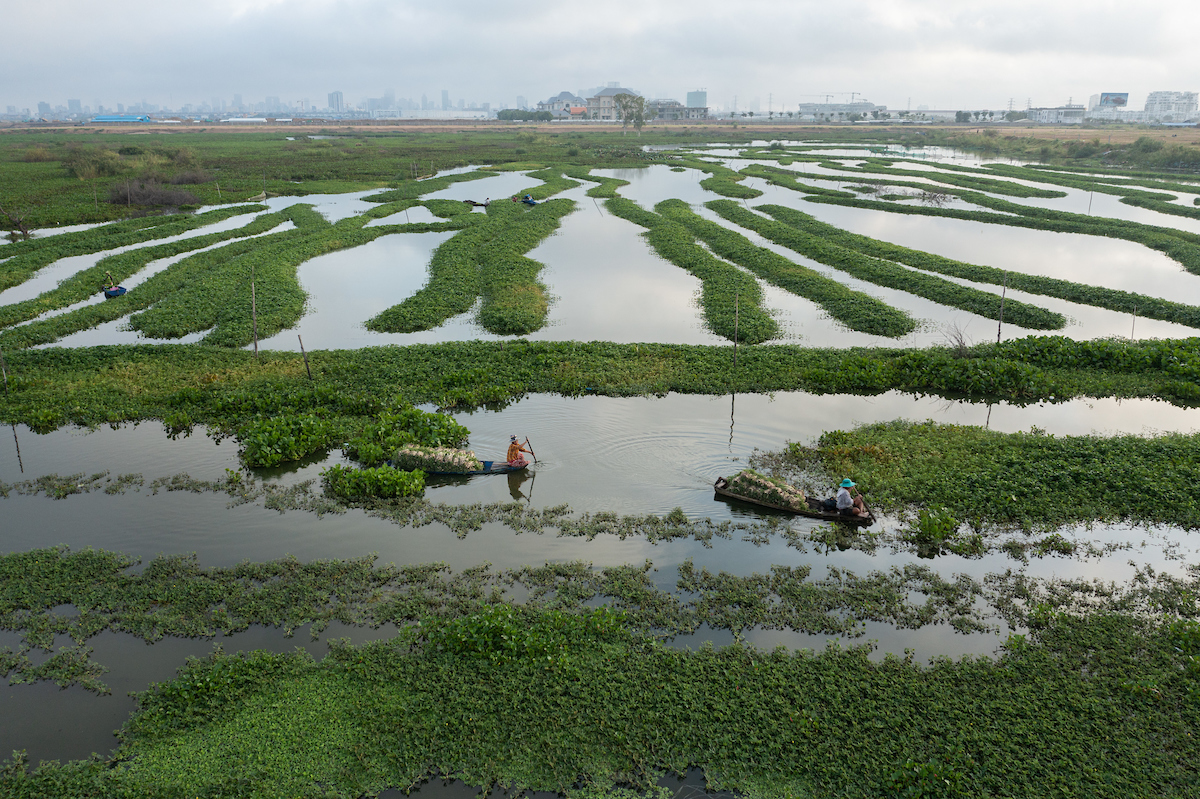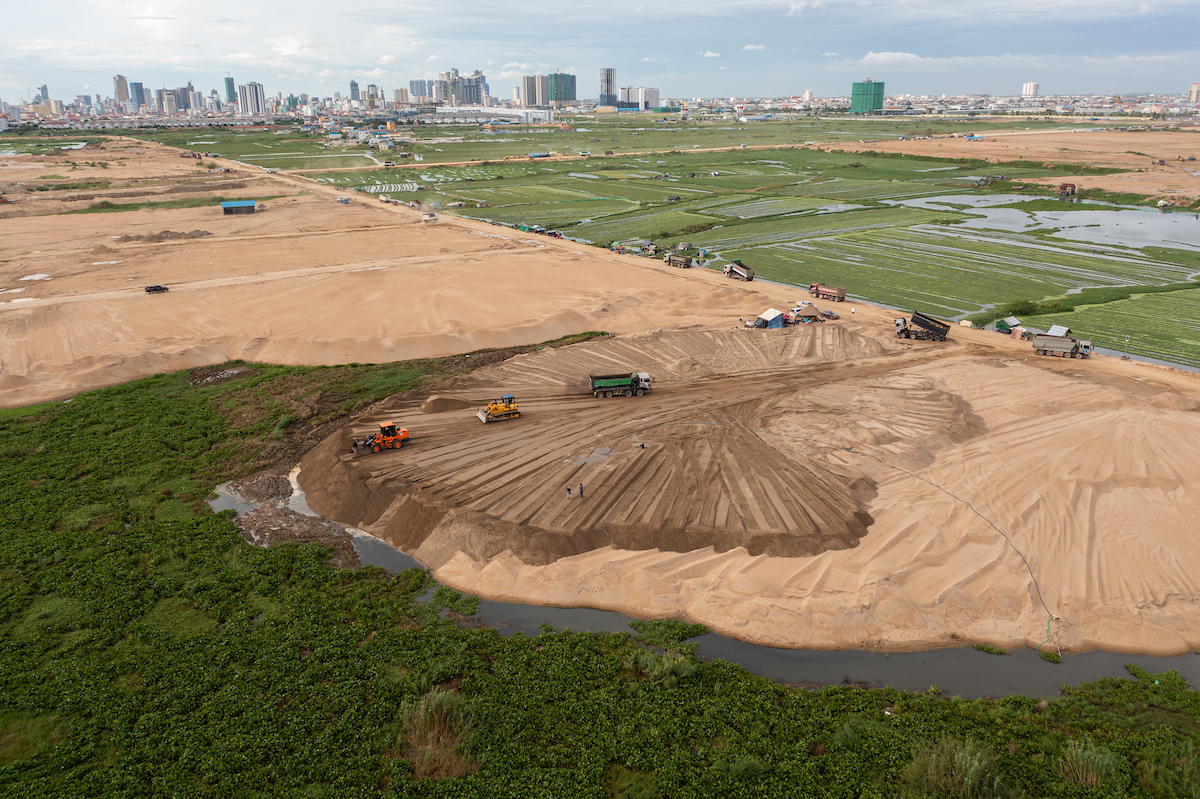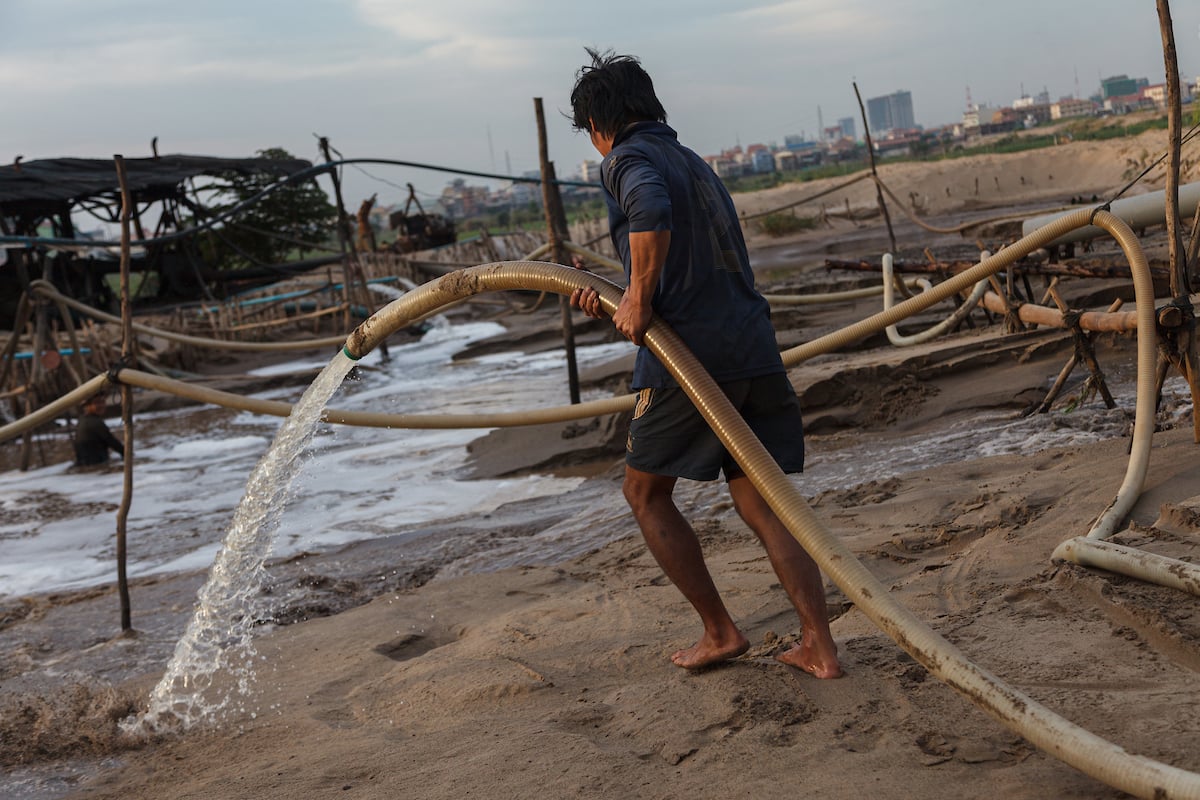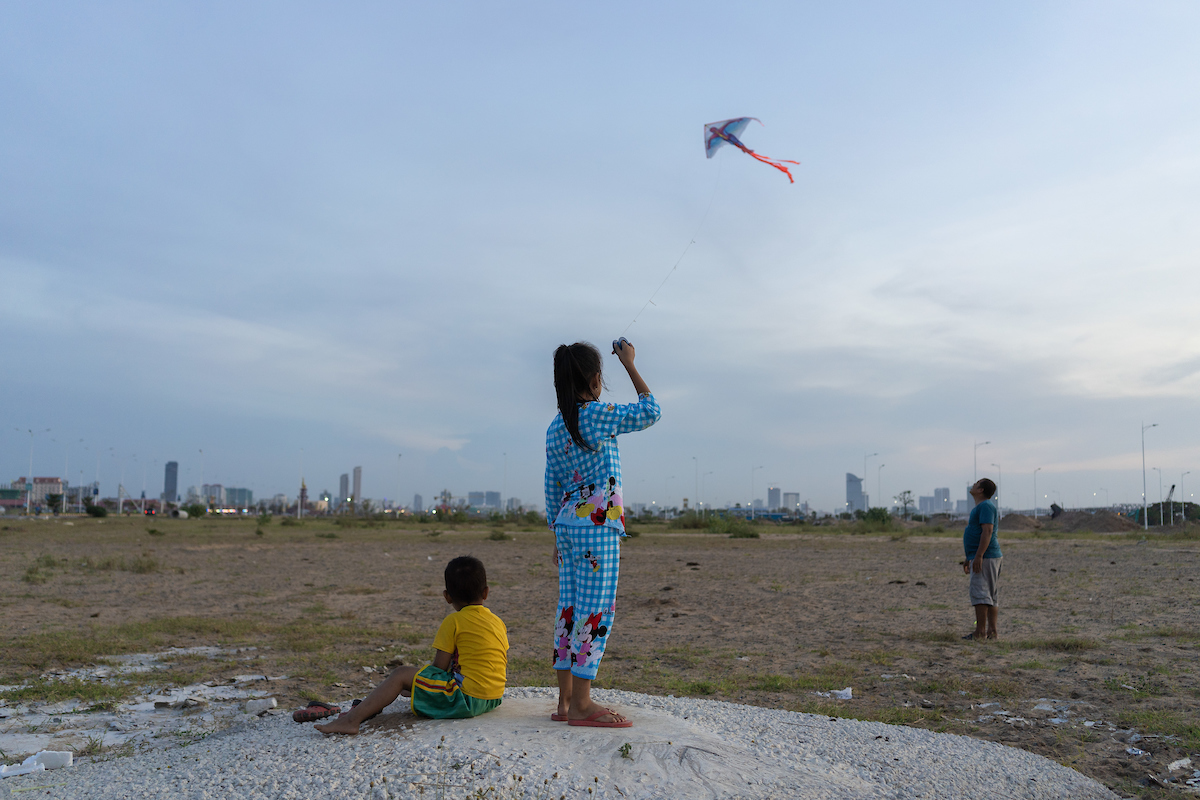

The Cambodian government is embarking on a number of ambitious development projects, which critics say come at the expense of the environment and people’s livelihoods
Main photo: Sophea Soung has been cultivating vegetables – such as this water mimosa – in Phnom Penh’s Tompoun Lake for over a decade, but her livelihood is now under threat (Image © Thomas Cristofoletti / Ruom)
Sophea Soung has been farming on Boeung Tompoun, one of the few remaining lakes in Cambodia’s capital Phnom Penh, since 2009. Every day, her family rises with the sun to float through verdant waters on a slender boat and harvest vegetables, which they then transport to sell at the local fresh produce market.
The mother of three cannot imagine doing anything else for a living. But she has just learnt that her plot will soon disappear under mounds of sand. “I have loans and I don’t have any plans for running another business,” she says.

Tompoun is part of an area of wetlands south of the Cambodian capital that is being reclaimed for property development (Image © Thomas Cristofoletti / Ruom)
The Tompoun and adjacent Cheung Ek wetlands spill over 1,500 hectares in the south of the city. According to human rights watchdogs, 90% of their area has been slated for a massive property-development project, ING City. Since 2004, the lakes have been gradually filled with sand from the nearby Mekong and Bassac rivers to create land for the venture. When completed, the complex will feature opulent villas, condominiums, supermarkets, an international private school and more.
Rising demand for sand
While it might be among the most ambitious Cambodian land-reclamation projects in terms of scale, ING City is by no means unique. Phnom Penh has been experiencing a construction boom, which in the past decade has seen 16 lakes filled completely. Another 10 are currently being filled. This has put lakeside residents’ livelihoods at risk and has led to a rising demand for sand in Cambodia, which is often taken from the Mekong River.

Sand is being used to fill Tompoun Lake to create land for a massive development called ING City (Image © Thomas Cristofoletti / Ruom)
The economic slowdown spurred by the Covid-19 pandemic didn’t stop the developers. They kept inching closer to Soung’s farm as she plunged further into debt.
The pandemic has emptied many markets, while the middlemen buying Sophea’s produce pinched her fees. “I don’t have enough money to buy food for my family and I get less for my vegetables,” she says. Amidst it all, the news that she would be losing her lifeline without any compensation came as a shock.
This, according to Soeung Saran, executive director of land rights group STT, is at odds with the law. “She should get a fair compensation for what she lost,” he says. “People are still worrying about losing their livelihoods. The government never consulted them. Their future is still in limbo.”

A heavily laden barge brings sand to another reclamation area on the outskirts of Phnom Penh, Cambodia. The Koh Norea satellite city will cost an estimated USD 2.5 billion. (Image © Thomas Cristofoletti / Ruom)

The sand is mixed with water, then pumped from the barges to the land reclamation area through pipes (Image © Thomas Cristofoletti / Ruom)
Sophea Soung’s is one of a thousand farming and fishing families whose livelihoods and homes are threatened by what could be Cambodia’s largest land-reclamation project, says a report jointly published by local human rights groups last year.
Increased environmental risks
The destruction of the wetlands, which act as a wastewater treatment and flood-prevention system, the report says, will also have far-reaching consequences for the environment and will expose more than one million people to increased risk of flooding.
Phnom Penh City Hall spokespersons did not respond to The Third Pole’s requests for comment. Last year, government spokesperson Phay Siphan told Reuters that the project was necessary for the city’s development, assuring that an environmental impact assessment had been conducted, and measures addressing wastewater and flooding taken.

Phnom Penh is in the midst of a construction boom. Across the Bassac River from the Koh Norea satellite city is Koh Pich (Diamond Island), home to some of the city’s most ostentatious building projects. (Image © Thomas Cristofoletti / Ruom)

Many of the new developments are luxury residences. Situated to the north of the capital, the Grand Phnom Penh International City was built on land reclaimed from the Boeung Reach Sei Lake. (Image © Thomas Cristofoletti / Ruom)

Phnom Penh’s rapid expansion outwards is being mirrored in the city centre, where tower blocks are transforming the skyline. As the main ingredient in cement, sand is in high demand here too. (Image © Thomas Cristofoletti / Ruom)
The race to create more land and feed the construction industry could have increasingly disastrous consequences elsewhere along the Mekong River, as sand found on the lakebed is the main ingredient in cement.
Sand is far more than a building block for cities. It also makes up the spine of the river. Without a fresh influx of sand to replenish the riverbed, erosion eats into the banks, sometimes leading to their collapse.

Much of the sand being used to feed the construction boom in Phnom Penh is being dredged from the Mekong and Bassac rivers (Image © Thomas Cristofoletti / Ruom)
Experts have long warned of the cumulative impacts of unbridled sand mining and mainstream dams. “The payback is coming,” says Marc Goichot, WWF’s freshwater lead for the Asia Pacific.
Upstream hydroelectric power dams straddling the Mekong – 11 in China and two in Laos – have already trapped 80% of the river’s sediment load. “This ratio is probably greater for coarse sediment, so we have lost more than three-quarters of the sand,” says Goichot.
Whatever is left gets scooped out or dredged, increasingly at rates that raise concerns about the sustainability of river mining.

Upstream hydropower dams on the Mekong and its tributaries are trapping sediment. This, combined with high levels of sand extraction, has led to increased erosion, not only in Vietnam’s delta region but also in Cambodia. (Image © Thomas Cristofoletti / Ruom)
Dangerous extraction rates
A study published in 2020 in the journal Nature Sustainability estimates that the amount of sand flowing downstream to the Mekong Delta is significantly smaller than current extraction rates in the region, linking sand mining to “bank instability potentially damaging housing and infrastructure and threatening lives”.
Figures supplied to The Third Pole by the Ministry of Mines and Energy indicate that the sand mining craze in Cambodia has only just begun. The extraction rate from the Mekong and Bassac rivers rose from 6 million cubic metres in 2019 to 10 million – the equivalent of 4,000 Olympic-size swimming pools – in the first quarter of this year.

The destruction of the wetlands around Phnom Penh will expose the city to a greater risk of flooding, according to an NGO report released in 2020 (Image © Thomas Cristofoletti / Ruom)

The severe flooding in Cambodia last year damaged dozens of garment factories and impacted more than 130,000 families (Image © Thomas Cristofoletti / Ruom)
According to Goichot, these volumes are well above replenishment rates, which annually stand at 5 million cubic metres. “So by definition if you extract more than the entire basin produces then it is not sustainable,” he says. “In the future even if we reduce the sand extraction in Cambodia we’ll still have a problem. Houses will be falling into the river.”
While to date this has predominantly been an issue further downstream in the Mekong Delta in Vietnam, where an area the size of the Netherlands has been sinking, some Cambodians have already lost their homes to the river.
In April and May, a number of houses and businesses 30 minutes north of Phnom Penh crumbled into the Mekong, with residents reportedly blaming nearby sand-dredging operations for their plight.

A girl plays with a kite on an area of wetland that has been filled with sand for property development on the outskirts of Phnom Penh (Image © Thomas Cristofoletti / Ruom)
In their statement to The Third Pole, the Ministry of Mines and Energy refuted villagers’ allegations and asserted that all sand-mining operations have undergone a social and environmental impact assessment, while houses have been falling into the river due to natural causes beyond their control. Sand mining along the Mekong, the ministry said, is sustainable and “has contributed to stimulating the country’s economic development”.
The images in this story can be republished as part of this article, but not independently of it. Credit information should not be changed.
Source
Language of the news reported
Copyright © Source (mentionné ci-dessus). Tous droits réservés. Le Land Portal distribue des contenus sans la permission du propriétaire du copyright sur la base de la doctrine "usage loyal" du droit d'auteur, ce qui signifie que nous affichons des articles de presse pour des fins d'information non commerciales. Si vous êtes le propriétaire de l'article ou d'un rapport et que vous souhaitez qu'il soit retiré, s'il vous plaît nous contacter à hello@landportal.info et nous le supprimerons immédiatement.
Divers articles de presse liés à la gouvernance foncière sont publiés sur le Land Portal chaque jour par ses utilisateurs, à partir de diverses sources, telles que les agences de presse et d'autres institutions et individus, ce qui représente une diversité de positions sur tous les sujets. Le droit est à la source de l'article; la Land Portal Foundation n'a pas le droit de modifier ou de corriger l'article, ni d'endosser son contenu. Pour apporter des corrections ou demander la permission de republier ou toute autre utilisation de ce contenu, merci de contacter le titulaire du droit d'auteur.
